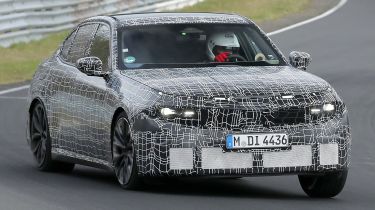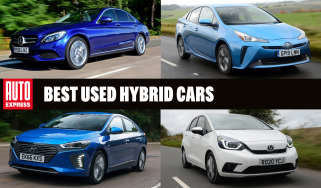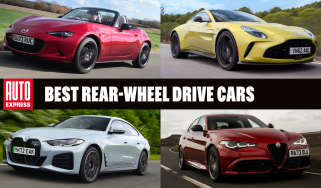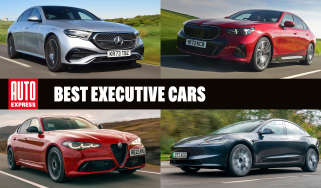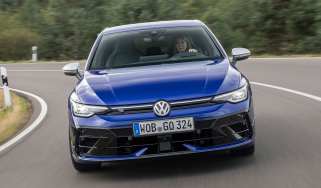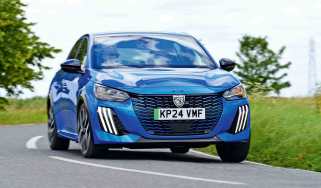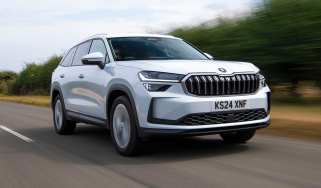New BMW 3 Series spotted testing with quad exhaust pipes and petrol power
The next BMW 3 Series will be unveiled in 2026, offered with a choice of internal-combustion engines and pure-electric powertrains
The new BMW 3 Series has been spotted testing once again. This time not only did we capture the next iteration of the genre-defining sports saloon on the gruelling Nurburgring race circuit, it was a petrol, presumably straight-six-powered version.
The quad exhaust pipes are a bit of a giveaway that this particular prototype is the future BMW M340i – the last stop in the 3 Series line-up before the full-fat BMW M3 – as are the 20-inch wheels and red brake calipers.
The 3 Series hasn’t been shying away from the cameras during its exhaustive development process, and we’ve seen both internal-combustion and pure-electric versions out and about being whipped into shape ready for the car’s world debut next year.
However, the show-stopping Vision Neue Klasse concept revealed in September 2023 already gives us a clear picture of what’s underneath the camouflage. It introduced us to BMW’s next-generation design language, and will inform almost everything we see from the brand over the next few years.
Visualised by our exclusive images, the front end will be defined by a new interpretation of BMW’s iconic kidney grilles, which are slimmer and much wider than those on some existing models, such as the 4 Series coupé or 7 Series limousine. and now wrap around the face of the car. The kidney grilles will also house some of the sensors and other technology needed for any advanced driver-assistance systems fitted.
From our spy pictures we can also tell that the combustion and electric versions of the 3 Series will look almost identical, but with a few differences in proportions. The EV, for example, appears to have a shorter bonnet, sleeker windscreen angle and more pronounced wheelarches. By contrast, ICE-powered models will have a very similar front end, but their bonnets will be longer and slightly lower to accommodate both four and six-cylinder engines.
The fairly traditional three-box saloon shape will still feature across the range though, along with other modern interpretations of other BMW signature traits, such as the Hoffmeister kink in the rear door. Elsewhere, the simplified surfacing, flush door handles and tucked-in sills should help make what will likely be a heavy car look visually lighter.
Two different platforms for one car?
Auto Express understands the electric version of the 3 Series – which could reintroduce the i3 name previously used by BMW’s trailblazing electric city car, although that’s yet to be confirmed – will sit on an all-new, bespoke EV platform. Petrol-powered variants on the other hand will use the current model’s underpinnings, probably with a similar selection of engines, too.
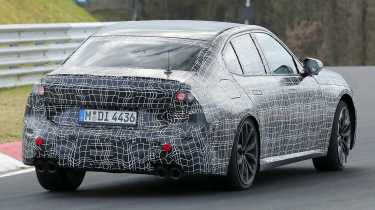
This approach of different 3 Series models that look similar, but have completely different underpinnings is a change from BMW’s other models, such as the 5 Series and 7 Series. In these cases, there are both ICE and BEV powertrain options on the same platform, which offer both advantages and compromises in regards to packaging.
However, this strategy was employed by sister brand MINI on its latest Cooper hatchback, which sees styling cues shared between the petrol and EV models, with slight differences to things such as the overhangs, roofline and door handles. The cabin design and tech onboard are identical.
Speaking of which, technology on the 3 Series will include BMW’s brand-new interior design concept called ‘Panoramic iDrive’ and its latest software. This set-up does away with an ordinary instrument cluster and has vital information projected across the base of the windscreen, while the central touchscreen is positioned to make it easy for the driver to reach and glance at, so they can focus on the road ahead.
How much range will the electric BMW 3 Series have?
The electric 3 Series will use a brand new and scalable platform that has been “uncompromisingly optimised for electric drivetrains”, according to BMW. It will feature an 800V electrical architecture, which allows for ultra-rapid charging speeds – supposedly fast enough to add 186 miles (300km) of range in only 10 minutes.
That’s thanks in part to BMW’s latest, sixth-generation eDrive powertrain technology, which uses cylindrical battery cells that deliver up to 20 per cent better energy density, 30 per cent more range and 30 per cent faster charging than current powerpacks. These cells will also be used as a part of the structure of Neue Klasse models, plus on certain cars, the batteries can be packaged differently to maximise space.

For context, the current BMW i4 electric saloon offers a range of up to 373 miles, which suggests the new i3 – or whatever it may be called – will manage more than 400 miles between top-ups.
Will this car be called i3?
As far as we know, BMW has still yet to decide on a name for the electric 3 Series, but the options include resurrecting the i3 name or retaining the 3 Series name with a modifier to signal its BEV powertrain.
Petrol variants will use a modified version of the current model’s underpinnings, but feature a new tech stack – or electronic architecture – consistent with the new EV versions. Powertrains will also be similar to the current model’s, with extensive application of mild and plug-in hybrid drive systems to help keep the cars as efficient as possible.
A next-generation BMW M3 won’t be far behind the regular 3 Series. It's set to be revealed in 2027 before going on sale the following year. It will also be offered with both petrol and electric powertrains – the latter is likely to use a quad-motor set-up that’s been in the works for a while, which we’re told can deliver up to 1,341bhp in its most potent form.
Can't wait until 2026? Take a look at our latest BMW 3 Series deals...
Find a car with the experts

